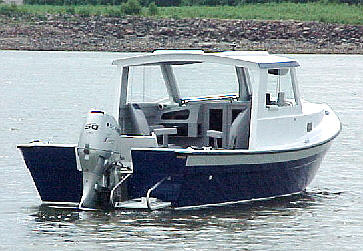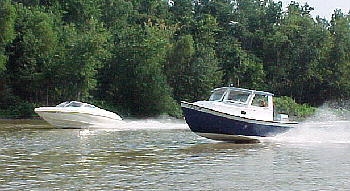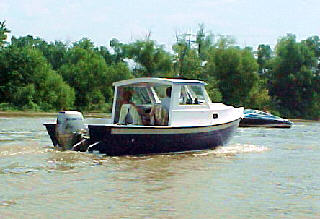|
If I was doing it again.......
But as with all projects of this size when I look back there are always things I now think I should have done differently. And at the same time there are changes that I made to the plans that I am happy I took the time to incorporate in to my CS. So what I think I will do here is list a few items that come to mind. They are in no particular order, just random thoughts. I will warn you I do tend to get long winded! Things I would change if building another Cabin Skiff. 1. I would pay very close attention to weight. When building an airplane this is something you get very paranoid about. Every ounce makes a difference! When building a boat it may not be that important but weight is a factor in the Cabin Skiff. I can easily tell a difference when 100 lb.. is added to the load. Both speed and way it cuts through the water is different. I passenger will reduce the speed by about 1 mph at a given RPM which in turn drops my MPG by 1 to 1/2. In my 19’ Bayliner I can drop 400 lb.. (3 additional passengers) and tell very little difference. I didn't weigh my CS but I have a good idea it came out heavy. In my opinion one of the reasons for this is the fact that I used white oak instead of mahogany. White oak is very strong but it also is heavy. If I were building the CS again would I use white oak? Yes, it is readily available and relatively inexpensive. But I would make some changes. I would do some research and explore the relative strength of both
white oak and mahogany. I am sure I could reduce the physical size
most of the white oak components without comprising the over all integrity
of the structure. For example I think I could probably reduce the
beams that support the cabin top by half. The structure is strong
enough that I can walk on the top and it just doesn't need to be that stout.
Common sense tells me I could have reduced the size of most all he hardwood
parts and probably saved 100 lb..
2. I would not encapsulate the wood with epoxy until
I had to. My personal feeling is this not only waste a LOT of epoxy
but again adds weight. Many areas will end up with multiple layers of epoxy
as the building progresses so why add more if not absolutely necessary.
Plus it can cause more work. I encapsulated all the planking
used for the hull. But every time I needed to attach anything I had
to wipe and sand the areas to insure good adhesion. Sand for all
the chine fillets, long beams, the inner and outer shear and every
other assembly attached to the hull.
3. Use Marine Plywood for the hull. I used two
sheets marine plywood for the bow section of the CS but used exterior for
the rest. If doing it again I would use marine for the entire hull.
Yea, I saved a few bucks but in relation to the total cost of the project
the difference for the marine plywood is minor. For everything above
the hull I used the exterior and would again. If my boat sat outside
365 days a year I might go all marine but mine will live most of its life
indoors sitting on the trailer. For my money the exterior will serve
just fine here.
5. Use laminated glass for the windshields. For
the side windows I used Lexan and I feel that was a good choice.
On the windshields I used laminated glass. I feel the plastic would
not serve well on the windshield because of the bug splats incurred when
trailering. Cleaning these off would surely scratch the plastic.
But actually I do not think I would use the laminated again on the windshields.
I know this is against the rules of safety but I think I would use regular
double strength glass. The reason for this is that the thinnest laminated
glass I could get was still 1/4” thick and together the two pieces
are quite heavy. This would be my choice but maybe not the best for
you. It's that weight thing again.
6. Building fiberglass tanks. I do not think I
would build in the fiberglass fuel tanks again. Although the coating
I applied “seems” to be holding up well this is still a big question mark
in the finished project. If I were doing it again I would probably
try to fit factory plastic tanks or custom build metal ones. There
is just too little accurate information available on the ethanol problem.
7. Check bottom flatness. Watch MUCH closer
the flatness of the bottom of the hull – especially near the transom. As
I have discussed eariler I have a problem that could have been easily fixed
while the hull was rolled over IF if had double checked the bottom flatness.
Things I would do the same.
2. Use the same paint. I used Easypoxy and Polypoxy
for the exterior and would do so again. I used a latex gloss
paint for all the interior and feel it will serve well. I also added
a mildew preventive to the latex as a precaution.
3. Adding the hatch on the berth. This did add
some weight. Actually more weight than it should as I got carried
away building the supporting structure. But I would do it again – only
lighter. It is really nice to anchor and pop the hatch and allow
the breeze to flow into the berth. Well worth the time and cost.
4. Screens for the berth doors. Along the same
line making the screens for the berth doors is worth the time. Really helps
for ventilation.
5. Making the side windows slide open. I mentioned
the reason in the previous page.
6. Adding the glove box and storage area.
These were placed in front of the passenger seat. Yea, again added
a little weight but it is very convenient. Worth the weight penalty.
7. Move the decks up to the top of the bulwarks
and curve the sides of the berth/cabin. I struggled with this decision
for quite a while but am very happy I decided to make the modification.
It was not nearly as difficult as I thought it might be and I really do
like the look. The little extra room in the berth didn't hurt either.
8. Build a boat. YOU BET I would do it again!
In fact, with the CS outside there is now a big open space in my shop and
it is just killing me to fill it. There are a lot of other things
I could construct but this boat building thing has really gotten under
my skin (and in my skin if you count the epoxy!). I am already looking
at other boat plans!
|

 4.
Adding 2’ to the hull length. I am not sure whether I would do this
again. The extra room is very nice but the main reason I did was
this was in the hope that I could carry four people. As I now know
the CS just doesn't handle this kind of weight well. At least in
my case it makes a nice two passenger craft. Maybe 3 with a light
load of fuel. And the lengthening did again add weight and require
a lot of extra material. But then again, it's nice to be able to set two
lawn chairs up on the sole facing the stern, and my wife and I prop our
feet up on the storage boxes over the fuel tanks and watch the sun set
over the water. Ain’t bad at all.
4.
Adding 2’ to the hull length. I am not sure whether I would do this
again. The extra room is very nice but the main reason I did was
this was in the hope that I could carry four people. As I now know
the CS just doesn't handle this kind of weight well. At least in
my case it makes a nice two passenger craft. Maybe 3 with a light
load of fuel. And the lengthening did again add weight and require
a lot of extra material. But then again, it's nice to be able to set two
lawn chairs up on the sole facing the stern, and my wife and I prop our
feet up on the storage boxes over the fuel tanks and watch the sun set
over the water. Ain’t bad at all.
 1.
Making the windshields vent. This did take quite a bit of time to
figure out and build, AND it did add additional weight. But I would
do it again as it really makes the cockpit considerably more comfortable.
1.
Making the windshields vent. This did take quite a bit of time to
figure out and build, AND it did add additional weight. But I would
do it again as it really makes the cockpit considerably more comfortable.